
Make Music With Mark Twain!
Music could be found in every facet of life in Mark Twain's Hartford home.
Learning about the role music played in this lively Gilded Age home enriches our understanding of the public and private lives of the Clemens family and the writing of Sam Clemens himself. In this spirit, the Mark Twain House & Museum offers “Make Music With Mark Twain,” a new hybrid virtual program for K-12 students. It allows music educators to work with the materials and resources of the museum to create cross-curricular projects that fit their needs and the needs of their students, including a public platform to safely share the work students produce with a broad audience.
With “Make Music With Mark Twain,” students don’t simply learn about what music meant to this family and home. This program gives them the opportunity to respond, perform, create, and connect—and then to share all of that with the thousands of people who visit The Mark Twain House & Museum’s website and virtual tour each month from around the world.
See how Farmington High School participated in this program in 2021.
Learn How the Program Works!
Music in the Clemens Family
For Sam Clemens, music was the thing that most strongly connected him to far-away places, to people he missed, and to his deepest emotions. After hearing a band play in Heidelberg, he wrote in his notebook:
It so warmed me, moved me, stirred me, uplifted me, enraptured me, that at times I could have cried and at others split my throat with shouting.
Even a wordsmith like Mark Twain could struggle to put his thoughts about music into words, but his creative descriptions reveal his affection for much of the music he heard, as with this description of a piece by Beethoven:
. . . that other deep, rich, noble Beethoven piece—the one where, all along and all along, half a dozen of the bass notes keep rolling back down-stairs a little way—only to the first landing and get up again and roll down again, and are the darling of the piece and the charm of it.
Skilled enough to frequently accompany his own singing on the piano, Sam Clemens was also deeply supportive of his children’s musical education and public performances. From his wife Olivia Clemens’ favorite hymns to their daughter Clara’s singing career, from the lavish operas the family enjoyed in Europe to the expensive-but-fiddly Swiss music box in the front hall of the home, music is key to understanding the lives of Sam Clemens and his family members, especially during the two decades they lived in Hartford.
How The Program Works
At the museum, we use primary sources, the objects in our collections, and the historic home itself to tell the story of the family that lived here. Each room in the house helps us tell part of that story. For this program, we’ve selected music that was important to Sam Clemens, his family, and his friends that can help us tell the story of each room—and even tell some new stories.
To participate in the program, educators first choose a room in the house. They then receive a packet containing museum resources which they use to design a project for their own students. Each packet contains:
- A full description of the room, its use, and the stories we tell with it
- A list of pieces that help tell those stories
- Historical scores for many of those pieces
- A collection of primary sources related to the stories and music, including private writing like letters and diary entries, and public writing like essays, memoirs, and fiction, all created by the Clemens family and their friends.
After an educator has created a project using the resource packet and begun working with their students, they can then schedule a 45-minute virtual workshop. The museum’s School Programs Coordinator, Erin Bartram, will join them live from the room they’re working on to give students a closer look, answer their questions, and talk about the relationship between the music, the house, the people who lived there, and the work that museum staff do today to interpret those things for the public.
When projects are complete, educators can submit their students’ work to be hosted on the museum’s website and embedded directly into our free virtual tour. Their work will not only be visible to a national and international audience, it will help the museum tell newer and richer stories, and demonstrate the important role that music plays in understanding the lives of people in the past.
The cost to participate in this program is $125. To ensure students can participate to the fullest extent, each live virtual session is capped at 25 students, but additional workshops can be scheduled for $50 each.
Note: this program will be available to book starting Wednesday, January 27th. Prior to that date, feel free to contact Erin Bartram with inquiries.
What kinds of projects can you do with this program? Here are some ideas!
Create a recording—You can produce a recording of any piece or part of a piece, any arrangement, any combination of voices/instruments, any way that works with your students and resources while also protecting their privacy.
Create a listening guide—Sam Clemens often struggled to appreciate some kinds of music, though he admitted part of the reason why: “I want to like it without taking the necessary trouble and giving the thing the necessary time and attention.” A listening guide is one way to help listeners understand a piece or style of music they’re unfamiliar with.
Analyze the text of a piece—Collaborate with your ELA colleagues to have students analyze and explain the structure, meaning, and themes present in a song’s words or an opera’s libretto.
Explain the history of a piece, a composer, a lyricist/poet, or a form—What are mazurkas, operas, and symphonies, and why could Clara Clemens only play one of them in the family’s drawing room?
Place a piece in its broader historical context—Collaborate with your social studies colleagues to have students explore and explain the history surrounding campaign songs, work songs, folk songs, and hymns.
Arrange a piece—While people of all social classes in 19th century America enjoyed going to the symphony or opera at times, they also knew these works through more accessible arrangements they could learn and perform themselves. Have students arrange Clemens family favorites!
Work across grade levels—Have more advanced students record the accompaniment to songs for students in younger grades.
Create more art!—The Clemens family loved transforming creative works from one form into another. Collaborate with colleagues in visual art, drama, and dance to illustrate, animate, choreograph, or otherwise transform the music the Clemens family loved.
This list is not exhaustive, and educators have full freedom to design whatever project they want with the resources provided to ensure it fits their curriculum and their students’ needs and resources. Collaboration with educators in other areas is welcomed and encouraged, and there are abundant opportunities to do so.

Choose Your Room!
Each description includes 3-4 examples of the types of pieces included, but the full packet for each room contains dozens of pieces with accompanying scores.
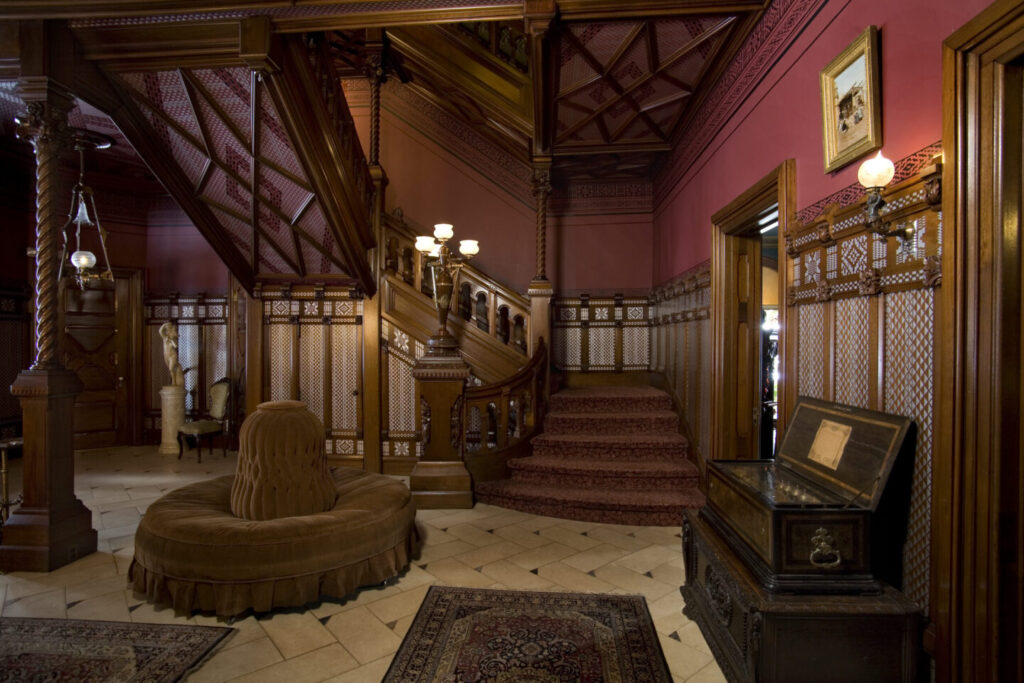
The Front Hall
The front hall, with its marble floors, intricate stenciling, and European furnishings, was designed to welcome and impress. This space housed a beautiful Swiss music box, purchased in 1878 when the family was in Venice. For as much as its delicate workings frustrated Sam Clemens, its music delighted his daughter Clara, who recalled the room itself as too dark for everyday family use but cherished her memories of the music box.
Music for this room includes the wide assortment of pieces that Sam Clemens considered and eventually chose for inclusion in the family’s music box, from opera to classical to popular song, as well as pieces related to his evolving ideas of “high” vs. “low” music.
Examples:
- “Auld Lang Syne”
- “The Last Rose of Summer”
- “God Save the Tsar!”
- “Anvil Chorus” from Verdi’s Il trovatore
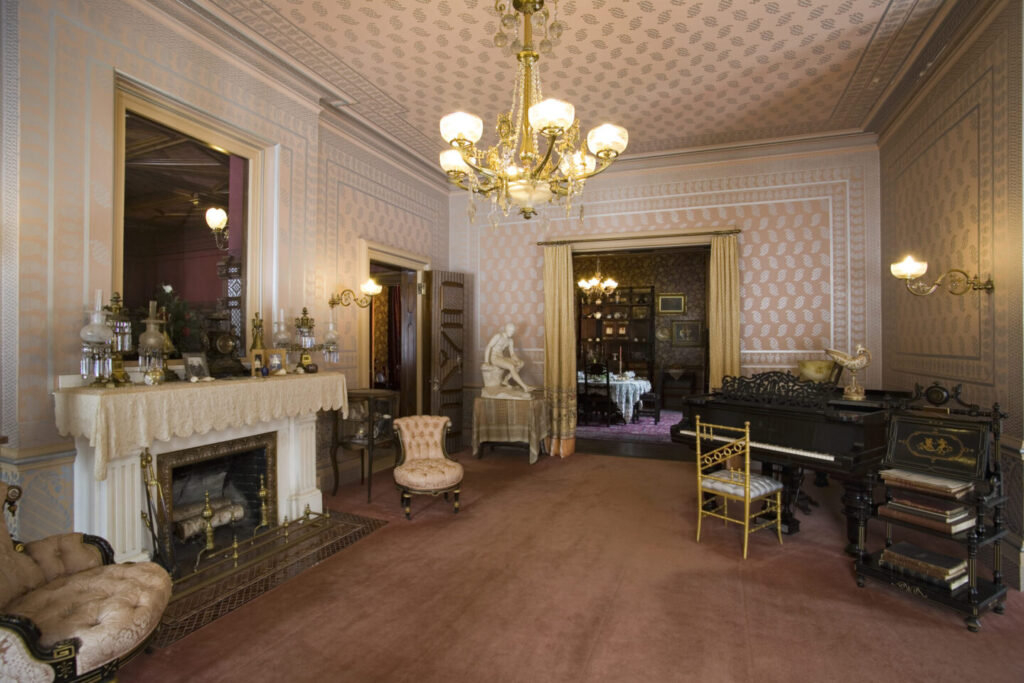
The Drawing Room
This bright, elegant room was used for formal entertaining in the evenings, and is full of beautiful furniture and art, but the Steinway & Sons piano that occupies one corner was certainly not there just for show. Whether it was Sam accompanying himself on tunes from his youth, his daughters performing for guests, or visiting musicians treating the family after dinner, music was often a part of entertaining in the drawing room.
Music for this room includes an assortment of the pieces that family members and visiting friends played and sang to entertain themselves and guests.
Examples:
- “Ye Banks and Braes of Bonnie Doon”
- Wagner’s “Les deux grenadiers”
- A variety of Chopin pieces for piano
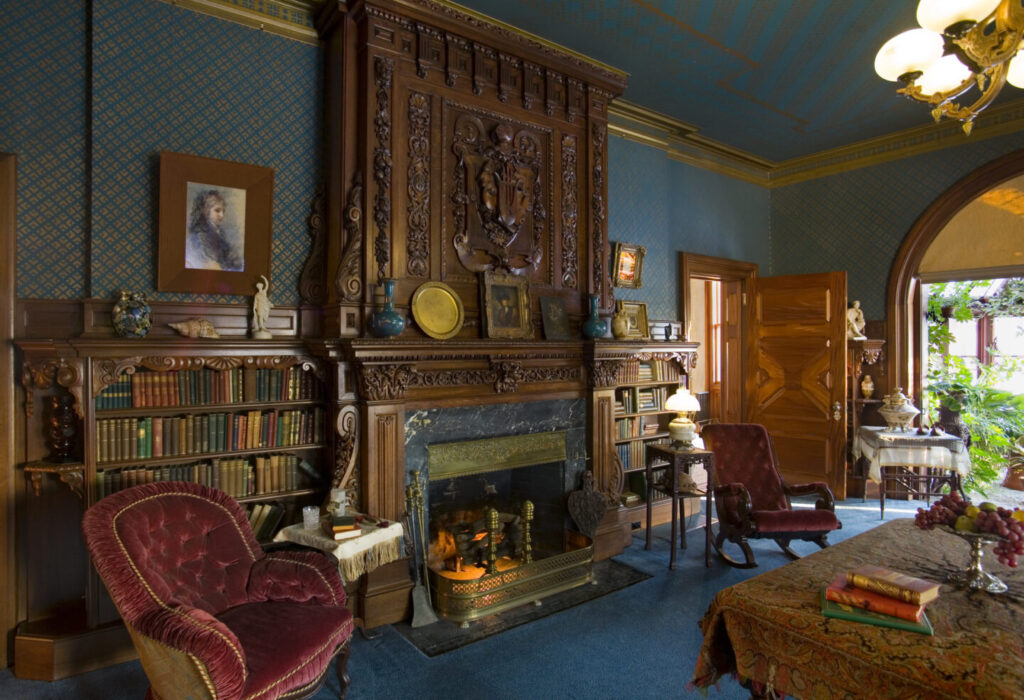
The Library
The library was a space for storytelling. In the evenings, for instance, the Clemens daughters would challenge their father to tell them a bedtime story using the objects on the library’s mantelpiece—-a different story each night! Sam used music often in his fiction and nonfiction, to set the scene, to communicate things about people and places, and to evoke emotions.
Music for this room includes pieces Sam used in his own storytelling and family favorites that tell compelling stories.
Examples:
- “The Trial of William Riley”
- “Marrowbones”
- “The criminal cried as he dropped him down” from The Mikado
- “Am I a Soldier of the Cross?”
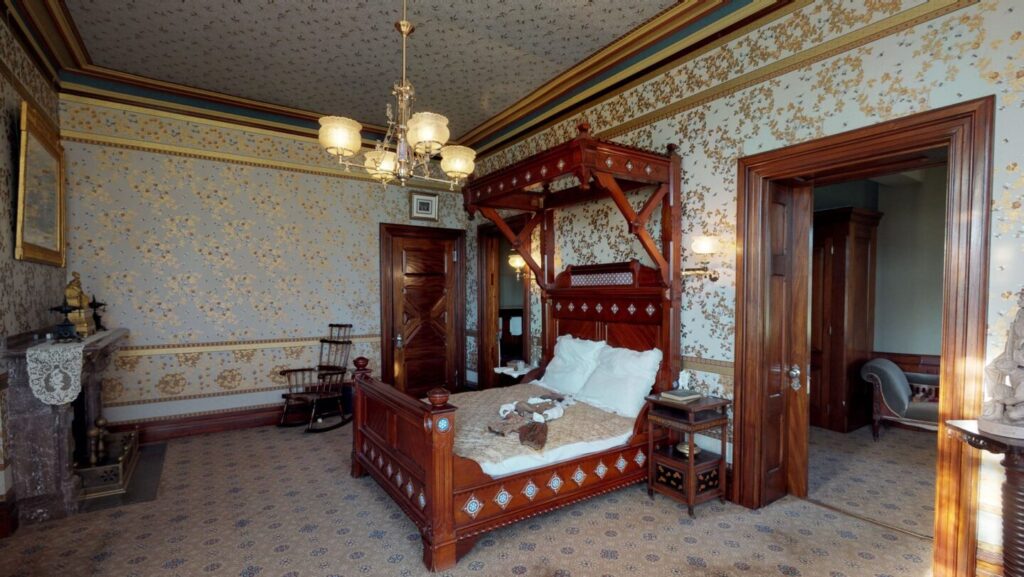
The Mahogany Bedroom
The centerpiece of a spacious suite off the library, set apart from the family rooms, the Mahogany Bedroom provided long-term visitors with a welcoming and private space. The Clemens family traveled extensively—for pleasure, to visit family, and in Sam’s case, for his career—and rarely occupied spaces as comfortable as the one they provided to their guests.
Music for this room includes pieces the family encountered or performed in the course of their travels around the world, from hymns on the Quaker City to operas in Europe.
Examples:
- “On Jordan’s Stormy Banks”
- “Blow the man down”
- “Hallelujah” from Handel’s Messiah
- “Bridal Chorus” from Wagner’s Lohengrin
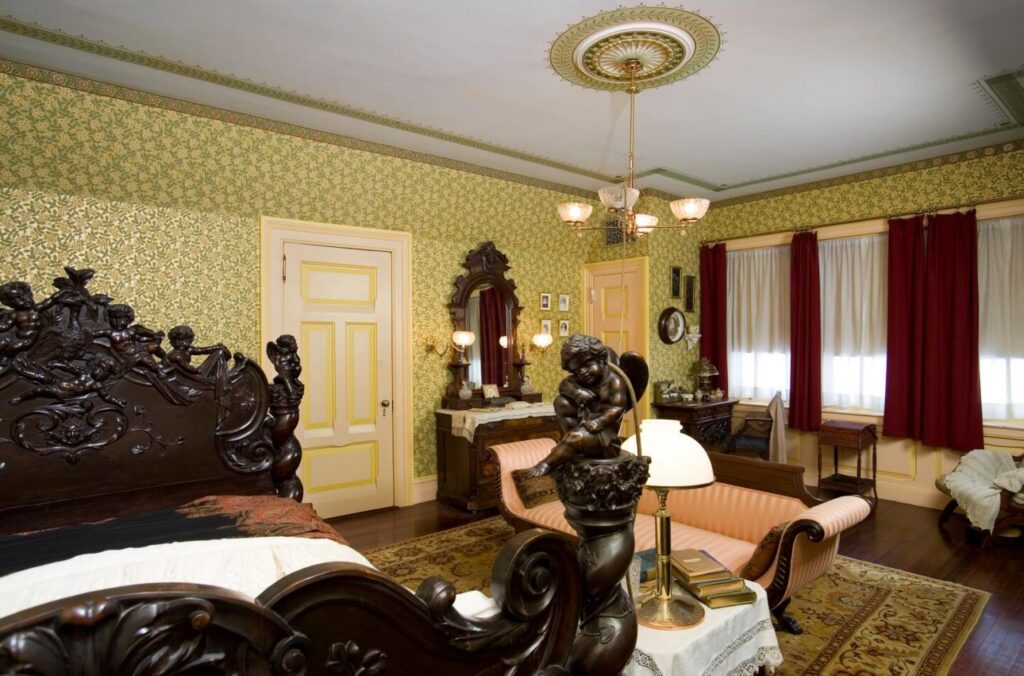
Sam and Livy's Bedroom & The Langdon Bedroom
The second floor of the house was the family’s space. At one end sat Sam and Livy’s bedroom and the guest room most often used by family members and close family friends when they came to visit. Olivia Langdon, Livy Clemens’ mother, spent several months in Hartford each year. As a result, the room was often referred to as “Mrs. Langdon’s room.” These rooms help the museum tell stories about the personal lives and family relationships of the people who lived here.
Music for these rooms includes the pieces that were most personal to the family, from the hymns that Livy and her mother treasured from their church in Elmira to the pieces Sam associated with people he loved.
Examples:
- Schubert’s Impromptu No. 2 in A Major
- “Lord, dismiss us with thy blessing”
- Beethoven’s Symphony No. 7
- “Good-bye, Sweetheart, Good-bye”
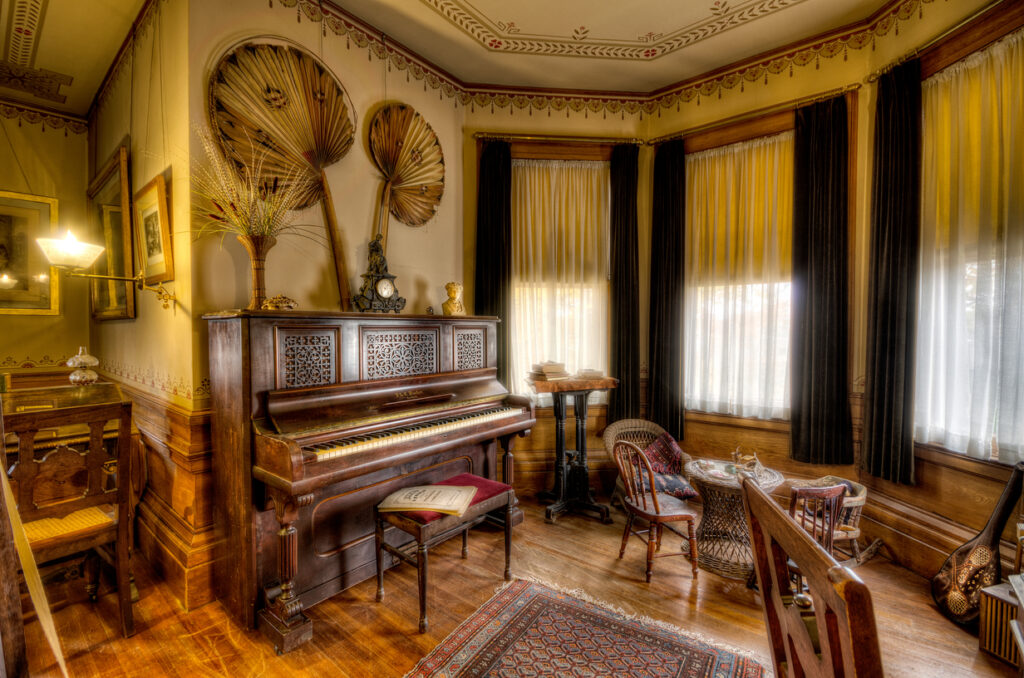
The Nursery & The Schoolroom
One end of the second floor was for adult members of the family, but the other end was very much the domain of the Clemens daughters. Music was a central part of the daughters’ education, as was the case with all girls of their social class in the Gilded Age, but when two of their three daughters showed real aptitude for and interest in performing, both Sam and Livy Clemens encouraged them in their pursuits and helped them access higher-level training with well-regarded teachers in Europe.
Music for these rooms includes dozens of 19th century nursery rhyme settings, as well pieces the Clemens girls learned as part of their musical education and performed for family and friends.
Examples:
- “Ring the Bells of Heaven”
- “My Grandfather’s Clock”
- “Bo-peep”
- “My Lady’s Garden”
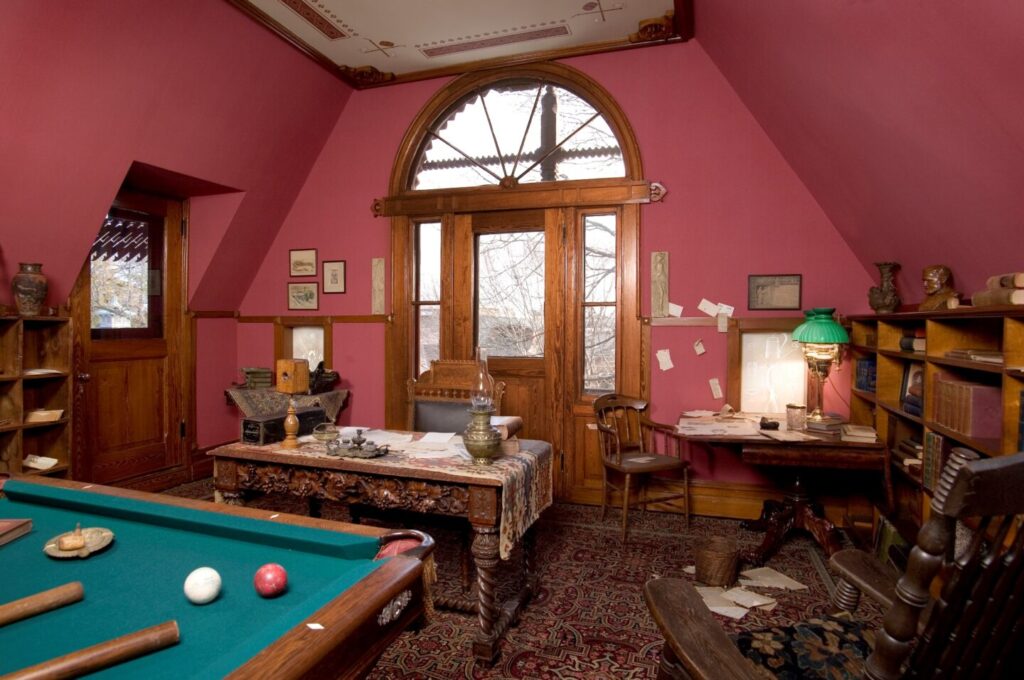
The Billiard Room
The Billiard Room was Sam’s domain—to talk with friends, to write letters, to avoid visitors, and to write and edit many of his most famous works. Those works often drew on his experiences as a young man, when a beautiful Connecticut home wasn’t yet on the horizon. Music was a part of those experiences as well, beginning with the songs he learned from his sister Pamela, a music teacher.
Music for this room includes pieces Sam Clemens learned as a child as well as music he encountered in his early life as a printer, riverboat pilot, miner, and journalist.
Examples:
- “A Wet Sheet and a Flowing Sea”
- “Larboard Watch”
- “Grasshopper Sitting on a Sweet Potato Vine”
Choose your room and get started!
Please select a room from the list below and tell us a bit about you and your students. After you submit this form, a staff member will be in touch with you to finalize your participation.
Note: You can schedule the live virtual portion of the program at any point after receiving your room packet by emailing grouptour@marktwainhouse.org.
Student programs at The Mark Twain House & Museum are supported by Lincoln Financial Group; The Brown Rudnick Charitable Foundation; the Charles Nelson Robinson Fund, Bank of America, N.A., Trustee; the Ellen Jeanne Goldfarb Memorial Charitable Trust; and the John and Kelly Hartman Foundation.
